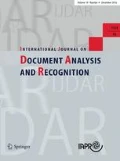Abstract
Automated recognition of unconstrained handwriting continues to be a challenging research task. In contrast to the traditional role of handwriting recognition in applications such as postal automation and bank check reading, in this paper, we explore the use of handwriting recognition in designing CAPTCHAs for cyber security. CAPTCHAs (Completely Automatic Public Turing tests to tell Computers and Humans Apart) are automatic reverse Turing tests designed so that virtually all humans can pass the test, but state-of-the-art computer programs will fail. Machine-printed, text-based CAPTCHAs are now commonly used to defend against bot attacks. Our focus is on exploring the generation and use of handwritten CAPTCHAs. We have used a large repository of handwritten word images that current handwriting recognizers cannot read (even when provided with a lexicon) for this purpose and also used synthetic handwritten samples. We take advantage of both our knowledge of the common source of errors in automated handwriting recognition systems as well as the salient aspects of human reading. The simultaneous interplay of several Gestalt laws of perception and the geon theory of pattern recognition (that implies object recognition occurs by components) allows us to explore the parameters that truly separate human and machine abilities.
Similar content being viewed by others
References
Baird, H., Popat, K.: Human interactive proofs and document image analysis. Proc. IAPR 2002 Workshop on Document Analysis Systems (2002)
Baird, H.S., Moll, M.A., Wang, S.: Scattertype: A legible but hard-to-segment captcha. Proc. 8th International Conference on Document Analysis and Recognition, pp. 935–939 (2005)
Belongie S., Malik J., Puzicha J.: Matching shapes. Proc. Eighth IEEE Int. Conf. Comput. Vis. 1, 454–461 (2001)
Biederman I.: Recognition-by-components: a theory of human image understanding. Psychol. Rev. 94(2), 115–147 (1987)
Biederman I., Gerhardstein P.C.: Recognizing depth-rotated objects: evidence and conditions for three-dimensional viewpoint invariance. J. Exp. Psychol. Hum. Percept. Perform. 19, 1162–1182 (1993)
Blum, M., von Ahn, L., Langford, J., Hopper, N.: The captcha project: completely automatic public turing test to tell computers and humans apart. http://www.captcha.net (2000)
Chellapilla, K., Simard, P.: Using machine learning to break visual human interaction proofs (hips). Adv. Neural Inf. Process. Syst. 17 (2004)
Chew, M., Baird, H.: Baffletext: a human interactive proof. Proc. SPIE-IST Electronic Imaging, Document Recognition and Retrieval, pp. 305–316 (2003)
Favata, J.T.: Character model word recognition. Proc. Fifth International Workshop on Frontiers in Handwriting Recognition, pp. 437–440 (1996)
Ho T.K., Hull J.J., Srihari S.N.: Decision combination in multiple classifier systems. IEEE Trans. Pattern Anal. Mach. Intell. 16(1), 66–75 (1994)
Impedovo, S. Wang, P., Bunke, H.: Automatic bank check processing. Machine Perception and Artificial Intelligence. World Scientific 28 (1997)
Jeager S., Lui C.L., Nakagawa M.: The state of the art in japanese on-line handwriting recognition compared to techniques in western handwriting recognition. Int. J. Doc. Anal. Recognit. 6, 75–88 (2003)
Kim G., Govindaraju V.: A lexicon driven approach to handwritten word recognition for real-time applications. IEEE Trans. Pattern Anal. Mach. Intell. 19(4), 366–379 (1997)
Koffka, K.: Principles of gestalt psychology. Harcourt Brace (1935)
Li, L., Ho, T.K., Hull, J.J., Srihari, S.N.: A hypothesis testing approach to word recognition using dynamic feature selection. Proc. The 11th IAPR International Conference on Pattern Recognition, pp. 586–589 (1992)
Lui C.L., Jeager S., Nakagawa M.: Online recognition of chinese characters: the state-of-the-art. IEEE Trans. Pattern Anal. Mach. Intell. 26, 198–213 (2004)
Madhvanath, S., Govindaraju, V.: The role of holistic paradigms in handwritten word recognition. IEEE Transactions on Pattern Analysis and Machine Intelligence 23(2) (2001)
Madhvanath, S., Govindaraju, V., Ramanaprasad, V., Lee, D., Srihari, S.: Reading handwritten us census forms. Proc. Third International Conference on Document Analysis and Recognition, pp. 82–85 (1995)
Park H.S., Lee S.W.: An hmmrf-based statistical approach for off-line handwritten character recognition. IEEE Proc. 13th Int. Conf. Pattern Recognit. 2, 320–324 (1996)
Pelli, D.G., Burns, C.W., Farrell, B., Moore D.C.: Identifying letters. Vision Research (2005)
Petersen S.E., Fox P.T., Snyder A.Z., Raichle M.E.: Activation of extrastriate and frontal cortical areas by visual words and word-like stimuli. Science 249, 1041–1044 (1990)
Plamadon R., Srihari S.: On-line and off-line handwriting recognition: a comprehensive survey. IEEE Trans. Pattern Anal. Mach. Intell. 22, 63–84 (2000)
Rice S., Nagy G., Nartker T.: Optical character recognition: an illustrated guide to the Frontier. Kluwer, (1999)
Rusu, A., Govindaraju, V.: The influence of image complexity on handwriting recognition. Proc. of 10th IAPR International Workshop on Frontiers of Handwriting Recognition (2006)
Rusu, A., Govindaraju, V.: Synthetic handwriting generator for cyber security. Proc. of 13th Conference of the International Graphonomics Society (2007)
Saon G., Belaid A.: Off-line handwritten word recognition using a mixed hmm-mrf approach. Proc. Fourth Int. Conf. Doc. Anal. Recognit. 1, 118–122 (1997)
Senior A., Robinson A.: An off-line cursive handwriting recognition system. IEEE Trans. Pattern Anal. Mach. Intell. 20(3), 309–321 (1988)
Shridhar M., Houle G., Kimura F.: Handwritten word recognition using lexicon free and lexicon directed word recognition algorithms. Proc. Fourth Int. Conf. Doc. Anal. Recognit. 2, 861–865 (1997)
Srihari, S., Keubert, E.: Integration of hand-written address interpretation technology into the united states postal service remote computer reader system. Proceedings of Fourth International Conference on Document Analysis and Recognition, pp. 892–896 (1997)
Xue H., Govindaraju V.: On the dependence of handwritten word recognizers on lexicons. IEEE Trans. Pattern Anal. Mach. Intell. 24(12), 1553–1564 (2002)
Xue, H., Govindaraju, V.: A stochastic model combining discrete symbols and continuous attributes and its applications to handwriting recognition. International Workshop on Document Analysis and Systems, pp. 70–81 (2002)
Xue H., Govindaraju V., Slavik P.: Use of lexicon density in evaluating word recognizers. IEEE Trans. Pattern Anal. Mach. Intell. 24(6), 789–800 (2002)
Author information
Authors and Affiliations
Corresponding author
Rights and permissions
About this article
Cite this article
Rusu, A., Thomas, A. & Govindaraju, V. Generation and use of handwritten CAPTCHAs. IJDAR 13, 49–64 (2010). https://doi.org/10.1007/s10032-009-0102-z
Received:
Revised:
Accepted:
Published:
Issue Date:
DOI: https://doi.org/10.1007/s10032-009-0102-z




